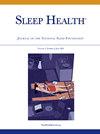睡前屏幕使用与成人睡眠健康之间的复杂关系。
IF 3.4
2区 医学
Q2 CLINICAL NEUROLOGY
引用次数: 0
摘要
目的:评估睡前屏幕使用是否与睡眠健康相关,以及这种关联是否因加拿大成年人的生理性别、年龄和收入而异。方法:通过加拿大全国分层随机人群电话访谈收集数据,调查成年人(≥18岁)的睡眠健康状况。使用过去一个月自我报告的睡前屏幕使用情况(在床上或睡前1小时内)将参与者分为三组:偶尔(结果:样本包括1342名成年人(51.5%女性;41.7%(40-64岁)和45.3%报告每天睡前使用屏幕。在考虑了生理性别、年龄和收入后,偶尔和经常使用屏幕的人都报告了最好的整体睡眠健康状况。结果因睡眠健康维度而异,生理性别是睡前屏幕使用和睡眠规律的调节因子。睡前屏幕使用频率仅在男性中与睡眠规律显著相关(p = 0.01)。结论:睡前屏幕使用与睡眠健康之间的关系似乎很复杂,因为睡前屏幕使用频率、测量的睡眠健康维度和生理性别都可以影响这种关系。需要更多的研究来了解成年人的睡眠健康和睡前屏幕使用的关联以及这种关系的调节因素。本文章由计算机程序翻译,如有差异,请以英文原文为准。
The complex association between bedtime screen use and adult sleep health
Objectives
To evaluate whether bedtime screen use is associated with sleep health and if this association varies by biological sex, age, and income among adults in Canada.
Methods
Data were collected through a national stratified random population-based phone interview on sleep health among adults (≥18 years) from Canada. Self-reported bedtime screen use (in bed or within 1 hour of bedtime) of the past month was used to classify participants into three groups: occasional (<once/week), moderate (1-4 times/week), and regular (≥5 times/week) bedtime screen users. Sleep health (regularity, satisfaction, alertness, timing, efficiency, duration) was measured using the RU-SATED questionnaire. Post-stratified survey weights were computed from the 2021 Canadian census to ensure representativeness of the adult population in terms of geography, biological sex, age, and ethnicity.
Results
The sample included 1342 adults (51.5% females; 41.7% between 40-64 years) and 45.3% reported bedtime screen use every day. After accounting for biological sex, age, and income, both occasional and regular screen users reported the best overall sleep health. Results varied by sleep health dimension and biological sex was a moderator of the bedtime screen use and sleep regularity association. Bedtime screen use frequency was significantly associated (p = .01) with sleep regularity only among males.
Conclusions
The association between bedtime screen use and sleep health appears complex as bedtime screen use frequency, the sleep health dimension measured, and biological sex can all influence this relationship. More research is needed to understand the sleep health and bedtime screen use association and moderators of this relationship in adults.
求助全文
通过发布文献求助,成功后即可免费获取论文全文。
去求助
来源期刊

Sleep Health
CLINICAL NEUROLOGY-
CiteScore
6.30
自引率
9.80%
发文量
114
审稿时长
54 days
期刊介绍:
Sleep Health Journal of the National Sleep Foundation is a multidisciplinary journal that explores sleep''s role in population health and elucidates the social science perspective on sleep and health. Aligned with the National Sleep Foundation''s global authoritative, evidence-based voice for sleep health, the journal serves as the foremost publication for manuscripts that advance the sleep health of all members of society.The scope of the journal extends across diverse sleep-related fields, including anthropology, education, health services research, human development, international health, law, mental health, nursing, nutrition, psychology, public health, public policy, fatigue management, transportation, social work, and sociology. The journal welcomes original research articles, review articles, brief reports, special articles, letters to the editor, editorials, and commentaries.
 求助内容:
求助内容: 应助结果提醒方式:
应助结果提醒方式:


